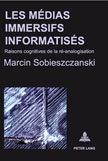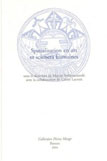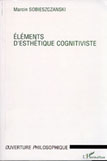
Sobieszczanski,
M., 2015, (sous presse), Les médias immersifs informatisés. Raisons
cognitives de la ré-analogisation, Bern, Peter Lang, 300 p.
Abstract
This study combines the
old-continental epistemology to the American pragmatic, presents a vast
synthesis of research and industrial solutions in all computerized media, based
on an immersive hypothesis that postulates the parallelism between the
evolution of the media and the evolution of computer peripheral devices. It
updates the cybernetic epistemo-praxeology in terms of neurophysiology: Media
are outsourcing the bio-cultural self-coevolution where the subject co-evolved
with the environment created by his own gesture. Their current progress is not
the development of devices but the development of sensory ergonomics capable of
producing intracranial effects of adherence to the narrative and fictional
figures. This technological trend culminates in the phenomenon of re-analogisation,
consisting of bio-inspired solutions, faster than binary algorithms, and
self-adapting face to the unpredictable changes. The re-analogisation is parallel
with the proliferation of communicating immersive environments that are
discussed in terms of concepts of naturalization and environmentalisation.

Sobieszczanski,
M., 2010, Du split-screen au multi-screen. La narration vidéo-filmique
spatialement distribuée (dir. de l'ouvrage collectif, en coopération
avec Céline Lacroix), From split-screen to multi-screen subtitle:
Spatially distributed video-cinematic narration (supervised by Marcin
Sobieszczanski in cooperation with Céline Lacroix), Bern, Peter Lang,
340 p.
Abstract
According to this study, the
spectator is currently acquiring new capacities to follow and to assimilate the
moving image. In the last fifteen years, designers in the iconosphere have
continued to make progress with the development and expansion of the media of
visual narration. This advance is not only the result of past artistic
experiments, but is above all rooted in such phenomena as the adaptation of
urban populations to dynamic iconography, the proliferation of visual
information, the emergence of interactive practices, such as channel surfing,
the Internet search, mobile phone interfaces, as well as the visual interfaces
for operating vehicles and other machines. These new ways of consuming images
and sounds have fueled an expansion of new multiscreen designs that will
gradually make the dark theater projection and the single-screen device
obsolete.
This bilingual French-English study offers a
semi-comprehensive investigation of these phenomena, anchored in the
epistemology of cognitive science, providing theoretical explanations combined
with analyses of recent and historical works and accompanied by the reflections
and testimonies of artists.

Sobieszczanski,
M., 2009, Les Demeures du Paraître, monographie sur Ernesto Riveiro,
avec la postface de Philippe Cyroulnik, édition du 19, CRAC,
Montbéliard, 120 p.
Abstract
This book is the first monograph devoted to Ernesto
Riveiro. You can discover the richness and complexity of his work with multiple
ramifications. It includes a study of Marcin Sobieszczanski a contribution of
Philippe Cyroulnik and numerous illustrations. Ernesto Riveiro was born in 1947
in Buenos Aires, Argentina, which he left in 1972 to settle in France. The work
of Ernesto Riveiro is characterized by a persistent pattern of the object that
can have a poetic votive or magical character, and by a large production of
paintings and drawings in which figures and landscapes are like appearance
instants in the movement of the gesture, the line and splash of colour.

Sobieszczanski,
M., 2004, Spatialisation en art et sciences humaines, (dir. de
l'ouvrage collectif, en coll. avec Céline Lacroix), Bruxelles, Peters,
270 p.
Abstract
Space is the foundation of all eventness. It is by
means of spatial relationships that any organization - as biological,
perceptual or active - reacts to its environment. But how to make the thought
of the living space a tool for understanding of our expressive and emotional
attitudes? From Alberti, Wölfflin and more recently with Panofsky or Damisch,
has reinforced a tradition endeavoring to bring the objects of symbolic space
to a conceptual matrix whose number of spatial attributes are the fabric. One
of the challenges of this reflection with many voices, conducted as part of the
work of the research team on Cultural Mediations and Communication Technologies
(MEDIATEC, University Nice Sophia-Antipolis), is to question the status and the
reality of "Space metaphor" at work in the humanities.

Sobieszczanski,
M., 2000, Éléments d'esthétique cognitiviste, Paris, L'Harmattan,
Collection Ouverture Philosophique, 380 p.
Abstract
One suggests a path
toward a cognitive aesthetics and a set of four studies where this aesthetics
appears as methodology and key of the interpretation. Art is perception, for
its material is the perceived world, its quest is of making present the existence
of this original perception, and its result is the object designed to being
perceived. One exercises a median way between 1) the gnoseological dualism of
Kant (the appreciable donation of things assumed by the understanding mind),
enclosed by some aspects of the thought of Husserl in the solipsism of the
absolute consciousness, 2) the absolutism of the Mind equalled with the subject
of the romantic. The sense is deducted at the same time from 1) some physical
and phylogenetic processes of the establishment of the conscience of the world,
2) morphological appearingness, thought by a philosophy which is structuring
the results of the cognitive sciences. Art is a doxothetic attitude carrying on
the perceptions of the world and operating on the basis of an ontology of the
personal, concrete and temporary. One oscillates, therefore, between the
approach of the art in the setting of Husserl's problematic of constitution and
the post-phenomenological one of ontology. One studies : In Dlubak, the problem
of the section that operates the physical limitations of the look on the
spatial situation of the tri-dimensional object and of its projection in the
subject's direction. In Bury, the morphogenetical effect of time in the change
of a blackening graphic photo deposit viewed mereologically. Beyond all modes,
the artist clings to the investigating of the irradiation that exercises the
world on the perceiving subject. In Riveiro, the back-up tentative of pictorial
corpus by the relinquishment of the framed picture, to the benefit of painting,
like a fluid process marrying multiple circulating panels together. A visual
ecology enlivens the endless process of the painter. In Caillaud, who combines
the painting of chromatic random paradigm and the digital dynamic, one observes
a "window to chronochromatic phenomena" where algebra and color go
together. So, one considers, not the differences between techniques, but the
technical differences existing between the various equivalences that the
artists constitute as operational in the mediation of their intuitions and of
their ostensive techniques.

Sobieszczanski,
M., 2000, Les artistes et la perception, Entretiens avec Z. Dlubak, J.
Bury, E. Riveiro et B. Caillaud, Paris, L'Harmattan, Collection L'art
en Bref, 100 p.
Abstract
In this book, four
artists interviewed by Marcin Sobieszczanski, talk about their artistic way to
gain possession of the given world. The artist interests us as one who sees the
world in his own way. His perception is expressed in different techniques
demonstrative that mobilizes as a contribution to the universal sense.






